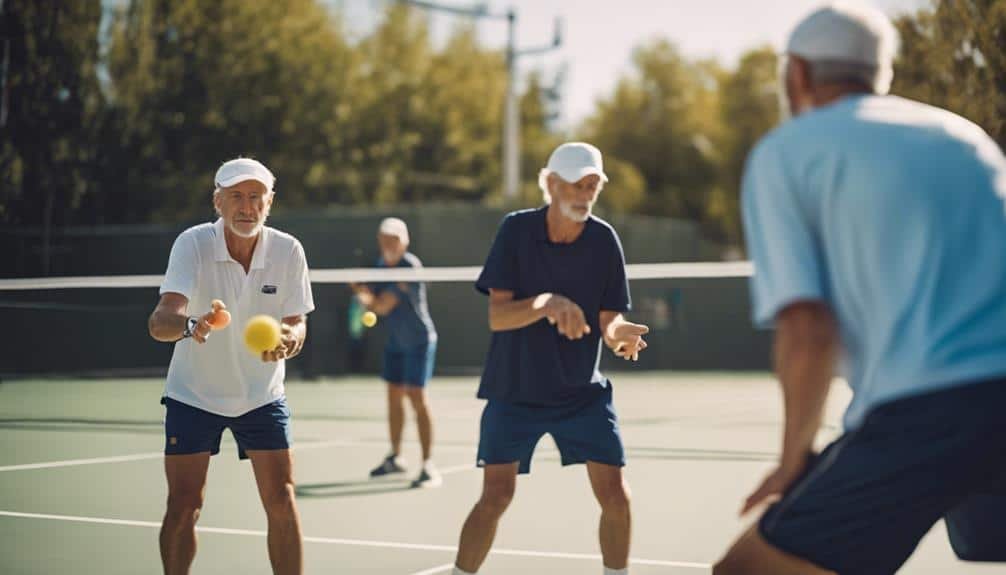I've cracked the code to error-free pickleball doubles. It's all about mastering partner play fundamentals and perfecting court coverage strategies. Clear communication, both verbal and non-verbal, is crucial. I analyze unforced errors systematically to identify areas for improvement. Mastering the third shot drop and transition zone tactics has significantly reduced my mistakes. I've developed team coordination drills that enhance our performance and confuse opponents. The mental game is just as important; I focus on developing a doubles mindset and visualizing success. By combining these elements, I've achieved doubles domination. There's more to uncover in the world of pickleball secrets.
Key Takeaways
- Master partner play fundamentals through clear communication and developing team chemistry to reduce on-court errors.
- Implement effective court coverage strategies by understanding court geometry and adapting positioning based on opponent analysis.
- Systematically analyze and reduce unforced errors by identifying patterns and focusing on actionable improvements.
- Optimize transition zone tactics and non-returner responsibilities to maintain control and minimize mistakes during crucial moments.
- Enhance mental game and team dynamics through visualization, mindfulness techniques, and developing a strong doubles mindset.
Partner Play Fundamentals

In pickleball doubles, mastering partner play fundamentals is crucial for maximizing team performance and reducing on-court errors.
I've found that understanding partner expectations and developing team chemistry are key components of successful doubles play.
When you and your partner work as a cohesive unit, you'll cover the court more effectively, anticipate each other's movements, and minimize confusion during rallies.
To build strong partner play, focus on clear communication, both verbal and non-verbal.
Establish consistent strategies for serve and return formations, court coverage, and shot selection.
I always emphasize the importance of supporting your partner, especially during transition zones.
For example, the non-returner should be ready to hit any fourth shots they can reasonably reach, protecting the returner and preventing uncontested middle attacks.
Court Coverage Strategies
Effective court coverage strategies form the backbone of successful pickleball doubles, enabling teams to control rallies and minimize opponents' scoring opportunities.
I've found that mastering court geometry is crucial for optimal positioning. By understanding the angles and distances involved, you'll anticipate shots more accurately and cover more ground efficiently.
This knowledge allows you to exploit weaknesses in your opponents' formation and create scoring chances.
Opponent analysis is another key component of court coverage. I always observe my adversaries' tendencies, strengths, and weaknesses to adjust our positioning accordingly.
This adaptive approach helps us maintain defensive integrity while setting up offensive opportunities.
Remember, effective court coverage isn't just about physical movement; it's about strategic placement and constant communication with your partner.
Communication in Doubles

While court coverage strategies lay the groundwork for successful doubles play, mastering on-court communication takes your partnership to the next level.
I've found that doubles synergy is built on clear, concise verbal cues and non-verbal signals.
Establish a set of pre-agreed calls for various situations: 'mine,' 'yours,' 'switch,' or 'stay.' These simple words can prevent confusion and collisions during fast-paced exchanges.
Partner chemistry develops as you learn each other's strengths and tendencies.
Use hand signals to indicate your intended shot or positioning.
Remember, effective communication isn't just about talking; it's about listening and responding.
Be aware of your partner's position and adjust accordingly.
Practice these skills during drills and matches to create a seamless, coordinated team.
Unforced Error Analysis
Analyzing unforced errors systematically is crucial for identifying specific areas of improvement in your pickleball game.
I've found that error pattern identification is key to unlocking your potential. By tracking and categorizing your mistakes, you'll reveal recurring issues that may be holding you back.
This process allows for shot selection optimization, enabling you to make smarter choices on the court.
As a 5.0 rated Senior Pro, I've learned that focusing on actionable items yields the best results.
Don't just count errors; understand their root causes.
Are you consistently missing third shot drops? Perhaps you're aiming too close to the net.
By giving yourself more latitude, you'll reduce these errors significantly.
Third Shot Drop Techniques

Building on our error analysis, I'll now address a common challenge in pickleball: mastering the third shot drop.
This crucial drop shot strategy can significantly reduce unforced errors and improve your overall game.
To execute it effectively, focus on soft touch techniques that allow you to clear the net consistently.
Remember, it's better to give yourself more latitude than to aim for a perfect shot.
I've found that many players struggle with trying to hit the ball too close to the net, leading to errors.
Instead, concentrate on getting the ball over with a gentle arc.
This approach will help you maintain control and set up your team for success at the net.
Non-Returner Responsibilities
Let's delve into the crucial role of the non-returner in pickleball doubles strategy.
As a seasoned pro, I can't stress enough how vital fourth shot management is for team success.
The non-returner's primary responsibility is to hit any reasonably accessible fourth shots.
This approach serves two critical purposes: it protects the middle court from uncontested attacks and shields the returner as they move through the transition zone.
By taking charge of fourth shot opportunities, we eliminate confusion and reduce errors, creating a more cohesive team dynamic.
Remember, pickleball isn't just about individual skill; it's about playing as a unified force.
When we master this strategy, we're not just improving our game – we're elevating our entire team's performance.
Embrace this role, and you'll see a significant boost in your doubles domination.
Transition Zone Tactics

The transition zone in pickleball presents a multitude of strategic opportunities that can make or break your game.
As a 5.0 rated Senior Pro, I've honed my transition zone tactics to perfection. Zone navigation is crucial for maintaining control and minimizing errors.
Move forward with purpose, timing your approach to the non-volley zone.
Stay low and balanced, ready to react to your opponent's shots.
Use split-step technique to improve your reaction time.
Team Coordination Drills
Effective team coordination drills are essential for developing seamless partner play and optimizing your pickleball performance.
I've designed a set of drills that'll enhance your doubles game, focusing on synchronized movements and communication.
One key drill involves practicing pickleball pivots, where you and your partner rotate positions seamlessly during rallies.
This improves court coverage and confuses opponents.
Another drill emphasizes doubles deception, teaching you to disguise your intentions and create uncertainty for the opposing team.
By mastering these drills, you'll elevate your partner play IQ and reduce unforced errors.
Remember, playing as a cohesive unit is far superior to individual efforts.
These drills will help you and your partner move as one, anticipate each other's actions, and dominate the court.
Commit to these exercises, and you'll see a marked improvement in your doubles strategy and overall performance.
Mental Game for Doubles

Mastering the mental game in pickleball doubles can make or break your performance on the court, influencing everything from decision-making to partner dynamics.
As a seasoned player, I've learned that mental preparation is crucial for success. Developing a doubles mindset requires focus, communication, and emotional control.
To elevate your mental game, consider these key strategies:
- Visualize successful plays and positive outcomes before matches
- Practice mindfulness techniques to stay present during rallies
- Develop a pre-serve routine to maintain consistency and focus
Advanced Partner Positioning
Advanced partner positioning in pickleball doubles requires a deep understanding of court geometry, player movement patterns, and strategic shot selection. I've found that mastering this aspect of the game can significantly reduce errors and improve overall team performance. Let's explore some key concepts:
| Position | Angle Adjustments | Positional Flexibility |
|---|---|---|
| At Net | Lateral shifts | Quick split-steps |
| Mid-Court | Forward/backward | Diagonal movements |
| Baseline | Wide stance | Crosscourt coverage |
| Serving | Sideline hugging | Ready for poach |
| Returning | Center positioning | Anticipate lobs |
These strategies allow for optimal court coverage and create opportunities for offensive plays. By incorporating angle adjustments and positional flexibility, you'll be able to adapt to various game situations more effectively. Remember, successful doubles play is about working as a cohesive unit, anticipating your partner's movements, and maximizing your combined strengths.
Conclusion
I've shared my hard-won secrets for error-free doubles play, but mastery requires practice.
While positioning and communication are crucial, don't neglect the mental game.
As you perfect your third shot drop, remember to hone your transition zone tactics.
Team coordination drills will solidify your partnership, yet individual skill development remains essential.
By implementing these strategies, you'll transform from reactive to proactive players.
Embrace these techniques, and you'll soon dominate the pickleball court with precision and confidence.

